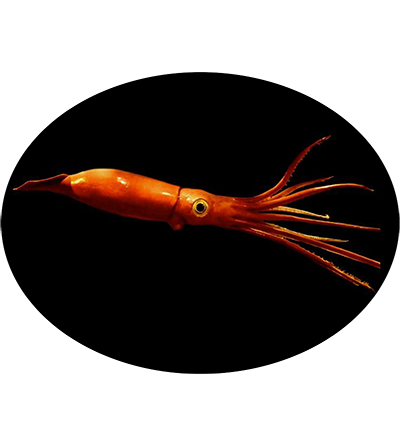
The giant squid Architeuthis dux is a species of deep-ocean dwelling squid in the family Architeuthidae. The mantle of the giant squid is about 2 m long, and the length of the squid excluding its tentacles rarely exceeds 5 m. Claims of specimens measuring 20 m or more have not been scientifically documented. And it is dicovered by a Japanese research team in 2004.
Animalia (Kingdom); Mollusca (Phylum); Cephalopoda (Class); Coleoidea (Subclass); Decapodiformes (Superorder); Oegopsida (Order); Architeuthoidea (Superfamily); Architeuthidae (Family); Architeuthis (Genus); Architeuthis dux (Species)
Architeuthis dux Steenstrup, 1857
1. Steenstrup J. Oplysninger om atlanterhavets colossale blaeksprutter[J]. Forhandlinger ved de Skandinaviske Naturforskeres, 1857, 7: 182-185. (Steenstrup et al., 1857)
The giant squid is a species of deep-ocean dwelling squid in the family Architeuthidae. It can grow to a tremendous size, offering an example of abyssal gigantism: recent estimates put the maximum body size at around 5 m (16 ft) for females, with males slightly shorter, from the posterior fins to the tip of its long arms. This makes it longer than the colossal squid at an estimated 4.2 m (14 ft), but substantially lighter, as it is less robust and its arms make up much of the length. The mantle of the giant squid is about 2 m (6 ft 7 in) long (longer for females, shorter for males), and the feeding tentacles of the giant squid, concealed in life, are 10 m (33 ft). Claims of specimens measuring 20 m (66 ft) or more have not been scientifically documented (from Wikipedia)
The giant squid is widespread, occurring in all of the world's oceans. It is usually found near continental and island slopes from the North Atlantic Ocean, especially Newfoundland, Norway, the northern British Isles, Spain and the oceanic islands of the Azores and Madeira, to the South Atlantic around southern Africa, the North Pacific around Japan, and the southwestern Pacific around New Zealand and Australia. Specimens are rare in tropical and polar latitudes.
| Species | Phylum | Common Name | Ecosystem | Depth | Habitat | NCBI Taxonomy ID |
|---|---|---|---|---|---|---|
| Architeuthis dux | Mollusca | giant squid | Hydrothermal vent | 200-1,000 | - | 256136 |
| Genome Assembly | Genome Size | Assembly level | Released year | WGS accession | Submitter | BioProject | BUSCO completeness (%) | Scaffold/Contig N50 (kb) | GC content (%) | Repeat Rate (%) | Gene Number |
|---|---|---|---|---|---|---|---|---|---|---|---|
| UP_Adux | 2.7Gb | Scaffold | 2019 | VCCN01 | CIIMAR - Interdisciplinary Centre of Marine and Environmental Research | PRJNA534469 | 90.40 | 4,852/5.7 | 36.1 | 48.21 | 33,406 |
| Title | Journal | Pubmed ID |
|---|---|---|
| A draft genome sequence of the elusive giant squid, Architeuthis dux | Gigascience | 31942620 |
| Gene ID | Description |
|---|---|
| pred2_44052.1 | PEROXISOMAL MEMBRANE PROTEIN PEX13 |
| pred2_44053.1 | TRANSPOSON |
| pred2_44054.1 | ELONGIN-C |
| pred2_44055.1 | MESODERM DEVELOPMENT CANDIDATE 2 |
| pred2_44056.1 | SERINE BETA-LACTAMASE-LIKE PROTEIN LACTB, MITOCHONDRIAL |
| pred2_44057.1 | - |
| pred2_44058.1 | INTER-ALPHA-TRYPSIN INHIBITOR HEAVY CHAIN FAMILY MEMBER |
| pred2_44059.1 | BIFUNCTIONAL POLYMYXIN RESISTANCE PROTEIN ARNA |
| pred2_44060.1 | METABOTROPIC GLUTAMATE RECEPTOR |
| pred2_44061.1 | PSEUDOURIDYLATE SYNTHASE |
| pred2_44062.1 | - |
| pred2_44063.1 | SCC1 / RAD21 FAMILY MEMBER |
| pred2_44064.1 | G-PROTEIN COUPLED RECEPTOR |
| pred2_44065.1 | - |
| pred2_44066.1 | VOLTAGE-GATED POTASSIUM CHANNEL |
| pred2_44069.1 | RUN AND SH3 DOMAIN CONTAINING |
| pred2_44070.1 | - |
| pred2_44071.1 | GUANOSINE-3',5'-BIS(DIPHOSPHATE) 3'-PYROPHOSPHOHYDROLASE MESH1 |
| pred2_44072.1 | PROTEIN NATD1 |
| pred2_44073.1 | HISTONE RNA HAIRPIN-BINDING PROTEIN |

